
..........................................................................................................................................................................................................
one of a perfect pair

i'm sure we've all heard the apocryphal stories of the cyclist(s) who orders a new frame each year in exactly the same colour as the previous year so that the beloved spouse is unaware of such frivolous expenditure. such procedure, if it ever existed at all, has surely been minimised by the current crop of carbon oriented frames with their namby pamby paint schemes that change every year. it's hard enough these days to acquire the frame colour you'd like, without managing to repeat the selection year after year.
but the absence of this marital iniquity has not lessened the physical or metaphorical scowl that heaps scorn upon any manifest form of regular cycling. lifting the honed physique from its repose early on a sunday morning is rarely met with the phrase "would you like me to get breakfast ready darling?". ok, maybe it is in your house, but it certainly doesn't feature in my hebridean conversation. however, despite grunting disapproval, it has yet to prevent my heading westwards to flex pent-up athleticism.
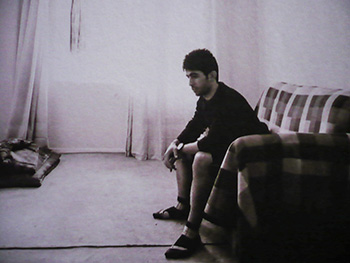
but regardless of these less than friendly periods of being shunned, those of us in the west have it pretty cushy really. as far as i know, no-one in europe, the uk or further west has been prevented from riding his or her bike due to their religious beliefs, subsequently having to accept refugee status in a neighbouring country while waiting for a decision on a request for political asylum in yet another country. but that's exactly what has happened to sina solouksaran, an iranian baha'i who has been banned from riding/racing his mountain bike in his home country.
in order to circumvent this situation, he has fled to turkey and applied for political asylum in the usa, but while that's solved one part of his dilemma, it has introduced another; he's not allowed to work.

i'm telling you all this because sina's story and interview form the opening feature in the latest issue of privateer magazine, the yin to rouleur's yang. issue seventeen mimics its publishing partner in adopting the minimal cover decor for which rouleur is justly famous. at least, as far as the subscriber issue is concerned. and just as important to those of us who consider ourselves amongst the cognoscenti of the printed word, the smell of ink upon paper is as prevalent and intoxicating as has forever been the case.
i am not a mountain biker; there are no knobblies other than cyclocross tyres in thewashingmachinepost bike shed. additionally the post owns an historical reputation as dealing principally with road-cycling culture; there are many other websites that impart the way of the mountain bike far better and more comprehensively than i could ever manage. so i pretty much leave them to it, and i don't doubt they are thankful that things remain that way.
i have also been long of the opinion, remiss though it may be, that mountain biking has much in common with that which disconnects britain and america: two nations separated by a common language. demonstrably speaking, cycling is cycling is cycling, no matter the tyre width you choose to make your own. it is common knowledge that a great many road bikes share shed space with their offroad counterparts, therefore it is only right and proper that their respective printed offerings share the same bookshelf.

while the uci seem hellbent on restricting any notable developments in road bicycle design, adhering to an 'if it was good enough for eddy' stance, mountain biking seems less in thrall to tradition, particularly since it's a tradition with a shorter timeline than that of the skinny wheels and bendy bars. an interview with jeff jones, a man who has seemingly re-invented the mountain bike from the ground up, ignoring any thoughts of tradition, is accompanied by a look at grass roots offroading, an interview with iron sally, a world cup weekend with cross-country exponents team orange monkey and, as the cliche goes, much more.
ally all this with photography that makes it a dawdle to flick through the pages simply looking at the pictures, framed with page layout worthy of applause, and you ought by now to be seconds away from clicking the subscribe button on the privateer website. issue sixteen was singularly concerned with editor andy waterman's trip through the american offroad scene, escorted only by photographer dan sharp.
at the time, it seemed it would be a hard issue to surpass, but in a similar manner regularly displayed by rouleur, it seems the scope and energy of privateer knows no bounds. the question is surely not why you should to subscribe to both magazines, but perhaps why you haven't already?
a six issue subscription to privateer costs £54. | privateer.cc
monday 23rd september 2013
 ..........................................................................................................................................................................................................
..........................................................................................................................................................................................................cafe du cycliste lou lou armwarmers and josette s/s jersey
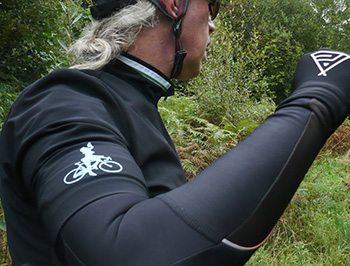
it is common practice in the world of percussives for cymbal manufacturers to mark their products with blatant hints as to how they think their crafted metals ought best to be used. thus the terms crash, splash, crash/ride, light ride, china type et al provide both the wary and unwary with a guide as to which particular model may well be the very sound for which they are searching. there are a couple of cymbal purveyors for whom this is not true; for instance, the italian ufip company prefer to mark the weight on the underside of each, though choice then becomes the province of the better sonically educated.

however, since there is not yet the equivalent of the cymbal police, there really is nothing to stop the percussively intent from purchasing a 22" heavy cymbal and hitting it very hard to simulate a crash rather than a ride. the choice depends greatly upon the music you play and the girth of your sticks (if you see what i mean). and it doesn't seem outwith the bounds of likelihood that the selfsame approach might be adapted to the world of cycling apparel.
cote d'azur based cafe du cycliste have grown from a minimal product line into one that ranks with the very best of the very best, offering a wide choice of jerseys, jackets and shorts that would allow the desirous velocipedinist to ride with comfort while retaining an harmonious degree of sartorial elegance. their bizarrely named josette waterproof jersey i have featured in these pixels on a previous occasion, but it dawned on me that as we enter both autumn and cyclocross season, its specific properties may lend themselves to hurtling through the undergrowth.
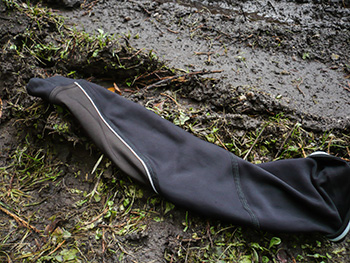
however, as remarked upon in my title, the josette features only short sleeves, something of a limitation as the temperature heads lower and lower, more than likely accompanied by substantial quantities of precipitation. and that's pretty much where their loulou armwarmers enter the fray. though the josette is filed under the heading of waterproof, and in light, persistent rain that is perfectly true, the loulou armwarmers offer no such protection. loulou is content with super-roubaix; but waterproof armwarmers are a rare item in the cyclist's armoury in any case, for who's truly worried if their arms get wet?
not me.

but spinning frantically around the innards of bridgend woods is apt to expose the limits of one's fitness, and as the scrabbling reaches less than smooth proportions, a lack of fitness is plain for all to see. in my case, that happens all too soon, displayed ominously via heavy breathing and hotness about the collar. as we all know only too well, the flexibility offered by a pair of armwarmers can ameliorate this unseemly display of uncoolness, a word that, in this case, makes use of both its meanings.
therefore, despite meeting an acquaintance on my first circuit and a fraser woodrow truck on the second, the third time round still necessitated a lowering of the arm defences for a welcome breeze engendered by marginally less speed through the estates. the attested waterproofing afforded by the josette is also a benefit that the average and not so average cyclocrosser can surely benefit from. though the rains have yet to turn the tracks into delineated quagmires, there are enough sporadic pockets of muddy water to keep one's torso in pretty much the condition it was in when it left home.
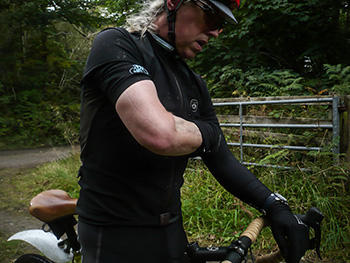
the cafe du cycliste website portrays the josette aboard a road bike. there is not a hint of scrabbly stuff. but just because it doesn't say crash on the packet, doesn't mean we can't make use of its ride properties.
does it?
the cafe du cycliste loulou armwarmers are available for £34 per pair; the josette waterproof jersey costs £139.
sunday 22nd september 2013
 ..........................................................................................................................................................................................................
..........................................................................................................................................................................................................the long race to glory. how the british came to rule the cycling world. chris sidwells. andre deutsch publishing hardback. 298pp illus. £19.99

lots of us are still asking how it happened. just how did britain manage to occupy the top position on the podium of a sport that it may conceivably have helped invent in the first place? generally speaking, we're not much use at anything at all, and more often than not, we revel in it. who can forget eddie the eagle edwards, britain's first competitor at the winter olympics as a ski jumper? at the time he was the british ski jumping record holder, number nine in the amateur speed skiing league and renowned for holding the world stunt jump record. he managed to get himself over ten cars and six buses.
however, come the winter olympics in 1988, eddie the eagle came last in both the 70 metre and 90 metre events. pretty much exactly what was expected of him and something for which he has become eternally famous. at one time, a similar fate more often than not befell britain's cyclists, particularly on the track, while performances in european road racing were patchy to say the least, any successful results arriving through the tenacity of individuals willing to brave the rigours of living abroad, unassisted.
chris sidwells has carefully and methodically documented this journey from complete obscurity to worldwide recognition, even if the journey to the top has been far longer than even that experienced by our american cousins. there are, of course, legitimate reasons as to why this has been the case; the lengthy ban on massed start road racing being a notable barrier. looking specifically at the history of track racing, though it's common practice nowadays to blame the government for everything, there may be some mileage in such apportioning of condemnation.
while many a former eastern european nation saw an investment in sporting prowess of whatever flavour as something of a standard bearer for their particular brand of communism, our own government certainly didn't see this as a flag to be waved for democracy. that is, until the commencement of the national lottery and the subsequent funding of many an olympic sport.
sidwells begins, however, with the earliest known cycling victory in europe by a british rider. on may 31st, in the parc st cloud, paris, james moore won a race organised by the olivier brothers. as sidwells mentions "James Moore must have been a very good rider, becasue he won the next big milestone in cycling, the first bike race on the open road."
though the franco-prussian war of 1870 put a stop to continental racing for a while, it later re-started on both sides of the channel, and moore continued his winning ways.
the long race to glory continues to comprehensively, if a tad briefly, take the reader through the early part of the 20th century, offering the an opportunity to discover hitherto unknown members of the british pelotonese. of necessity, there is an eclectic mix of road and track riders, including arthur linton, jimmy michael, charles davey and charles holland, (the first ever british rider to take part in the tour de france in 1937) ray booty, and reg harris amongst others.
however, though cycling harbours a myriad of european races over several different countries, cycling success for the uk civilian population really only has one colour: yellow. and the road to that particular glory was a long time coming. riders such as brian robinson, barry hoban and tom simpson achieved notable success in the tour de france, simpson also managing to garner world championship bands for his considerable efforts. however, given the profile of le tour itself, a race that has an infinite capacity to believe its own publicity handouts, top step on the parisienne podium is arguably the only one that counts.
of course, britain's cycling history concerns not only the male population; beryl burton also receives appropriate mention, as do yvonne mcgregor, victoria pendleton, nicole cook, emma pooley and others of note.
chris sidwells has all but achieved the holy grail of sports writing in being able to satisfy the interest of the cognoscenti while managing not to lose the attention of those with either a passing interest in cycling history or simply a rudimentary grasp of its technicalities. he has also managed to weave the rudiments of cycle development across the decades without ever becoming tedious or more involved than his narrative demands.
perhaps unsurprisingly the latter section of the book goes into far greater detail than is apparent in the early years and frankly, this skews all heavily in favour of wiggins, cavendish and froome via boardman and obree. it's an era of cycling that has perhaps received more than its fair share of exposure over the past few years or so. granted, there are some insights that i've not come across in the biographies of wiggins, froome and cavendish, but there is much that has been aired previously and recently. it's a similar situation regarding the exploits of chris hoy, craig mclean, jason kenny and other members of of the british olympic squad in both beijing and london.
one omission, however, bothers me slightly; throughout the chapters of the modern era of british cycling, there is no mention of brian smith, the scots rider who rode with motorola in the mid nineties and was twice british road race champion. strange that.
however, as britain has edged ever closer to gold and yellow, the media has analysed each and every pedal-stroke in far greater detail than was comparitively the case last century. it would perhaps be remiss of the author to have ignored this unprecedented availability of information, though a smidgeon more judicious editing might have presented a more overall balance. taken as a whole, those who left british shores for europe in order to carve a career as professional cyclists are portrayed as mere stepping stones to ultimate victory, despite their sacrifice being arguably of greater consequence than inhabiting today's sky machine.
as one who works in the publishing industry, albeit at a very low level, i'm well aware of the spelling error. no matter how often you read through a manuscript or article, it's alway likely that a mistake will sneak through. the defence against this is farming out the proofreading to as many individuals as makes economic sense. i've come across the occasional error in previous books for review, but they are usually isolated incidents and generally not worth remarking upon.
unfortunately, the same cannot be said of the long race to glory. the author shall remain blameless; this is simply the result of shoddy proofreading. throughout the book, joey mcloughlin's surname is spelt mcgloughlin, even in the index at the back. emma pooley gains a double l - poolley - again repeated in the index. on page 147, when discussing the offroad abilities of liam kileen, comes the phrase 'but he's back in training and looking forward to rio 2014.' in which case, he'll be there on his own a couple of years early.
come the stephen roche years, and his winning of the tour of italy; the irishman is quoted as saying "I had one team-mate with me, Eddy Schpers...". no doubt he was referring to eddy schepers. and while franz van looy is accredited to the telkom team, cavendish is credited as winner of the scheldedprijs, and wiggins apparently spent time reconnoitring in france.
with a bit of luck, these will be remedied when the book arrives eventually in paperback. to err is human, but there are limits.
however, these are probably noticeable predominantly to pedants such as myself and do not materially detract from the overall quality and integrity of the book. the title would rather alert you to its partisan leanings, for there is no attempt to place the british victories in context with the endless winning by other european nations. but in truth, that's not really the point here; the 298 pages are intended to let us feel good about ourselves, to rejoice in the yellow and gold that has eventually come our way and to offer virtual praise to those who have brought them to british shores along with those who preceded them.
long may it continue. (by the way, nice photoshop work on the cover).
saturday 21st september 2013
 ..........................................................................................................................................................................................................
..........................................................................................................................................................................................................curiouser and curiouser, cried alice.
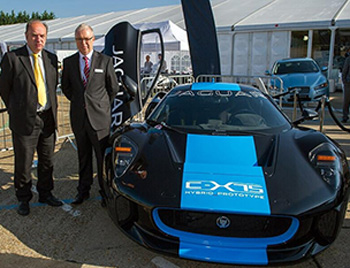
"These are exciting times for the motoring industry as ultra low emission vehicles are the future for road travel... This strategy moves us up a gear in pursuing that vision."
so sayeth norman baker, the government minister responsible for cycling. you are forgiven if you figure i may have misquoted the gentleman in question, but sadly that is not the case. for not only is mr baker in charge of cycling, he's also the minister responsible for electric motor vehicles, a situation that seems like it may contain a conflict of interest. surely?
or is that just me?
the minister recently informed any interested parties that spending on cycling facilities and infrastructure was the preserve of local authorities. he purports to see little need for government interference in such matters, despite a contemporary realisation that cycling can/does form an integral feature in the national transport strategy. the government recently announced a national sum of £114 million to benefit cycling in the uk, a number that equates to something like two miles of motorway, meanwhile setting aside £28 billion to spend on the roads.
rather obviously, the fewer cars using the roads, the less wear and tear and thus the lower an amount required to be spent on repairs and new roads. were the government to increase the amounts spent on cycling and encouraging more of the population to consider two wheels as a viable alternative to four, the more they could potentially save from the roads budget. it seems so undeniably logical, that it'll probably never happen.
but there is something of a dichotomy at work in government circles, for though norman baker may well be the gentleman to whom we must doff our collective caps should we wish to exert any influence, he is also the minister responsible for electric cars. and in response to questions regarding an overall vision regarding the latter, he is keen to stress that electric vehicles ought to benefit from a central, national strategy, guaranteeing a substantial amount of funding until at least 2020.
this includes so-called consumer incentives.
earlier this year, there was a strong likelihood that the government was setting up an office for active travel and bestowing upon it a rather more substantial sum of money than currently offered for cycling alone. the remit of this proposed office for active travel was presumed to involve persuading motorists to leave their cars, thus reducing congestion and ultimately leading to health benefits across the population. after deep discussion with both walking and cycling organisations, the idea was shelved.
the minister who would have been responsible for the office of active travel was norman baker.
but, as the comedian jiminy cricket was wont to say, "there's more." despite the walkers and cyclists of the nation losing out, car manufacturers suffered no such iniquity. the office for low emission vehicles has a mandate to boost (electric) car sales and i have already enlightened you as to who heads up this enterprise (you really couldn't make this up); norman baker.
his announcement which began with my opening quote, continued "As well as huge opportunities for the automotive sector, this will bring life-changing benefits to our towns and cities improving air quality and reducing carbon emissions and it will provide energy security by reducing our reliance on foreign oil imports." i make no apology for pointing out the obvious that increased bicycle usage, particularly within the realms of towns and cities, could be said to achieve exactly the same result.
and despite the fact that the government has earmarked the aforesaid £28 billion for roads spending, the office for low emission vehicles has evidenced in its own strategy document that 98% of all car journeys in the uk are below 50 miles. i've tried really hard to think of a sportive ride that takes place over such a short distance, but failed. man with a bike, lord carlos, who like me is in his mid-fifties, happily undertook a 22 mile round trip each and every day while editor at our local paper. this rather regular feat surely puts such distances within easy reach of a substantial portion of the population.
could it be that no-one in government is listening, or are there other manipulations at work? (that was a rhetorical question.)
friday 20th september 2013
 ..........................................................................................................................................................................................................
..........................................................................................................................................................................................................what's wrong with this picture?

doors are the problem.
at least so it would appear. you wander from one room to another, intent on carrying out a task or to convey words of great importance, then completely forget either or both. doors, or rather doorways are apparently to blame. it's a form of psychological aberration that affects much of the adult population, seemingly no respecter of age.
it's also a ruddy nuisance.
knowing this can often result in a self-fulfilling prophecy. doors are part and parcel of modern-day existence, every bit as common as the experience of completely forgetting what one is about, or those words upon which the world would hang. if only you could remember what they were. writing down those eureka moments would be a salient solution, but whoever is going to remember to do that?
windows, though not part of the same process, confer their own disparity between real life and that of make-believe.
is that what the girl in red is conveniently ignoring?
holburn street in aberdeen was home to a motorbike, moped and scooter dealer which occupied three corner shops in sequence. there was an obvious progression in delectability that stretched from grey and duck-egg blue scooters in window number one, all the way to window number three. the latter was home to large, powerful motorbikes such as honda's gold-wing. a window to watch, it would seem.
on each saturday afternoon, each and every window was obscured by orderly groups of leather jacketed gents carrying full-face crash helmets. the idea was undoubtedly to impress upon the innocent bystander that here was the future of the motorcycle world, au fait with the necessarily purposeful mode of attire, deep in consideration of their next set of wheels.
windows are for peering into or out of. though we have already discussed the importance of the doorway, few of the ascribed incumbents were keen to cross the threshold of any of the three on offer. windows and what lay beyond apparently fulfilled any requirement you may have thought necessary. in most cases, however, the innocent bystander remained as such.
the folly of observation was revealed just short of closing time on saturday afternoons. rather than fastening tattoed leather, donning tinted visors prior to roaring off into the evening melee, many stood dutifully at the bus stop; hell's public transport. all show and no go.
the lady in red remains content with her status as innocent bystander. i don't doubt that the three lads have impressive carbon resting nearby, but for now rely upon their fixation with froome's paris-bound challenge. when the big screen goes blank, they'll pop inside for froth and espresso.
the lady in red goes home on the underground, still listening, but not seeing.
(apologies in advance to the photographer. i have no idea who you might be.)
thursday 19th september 2013
 ..........................................................................................................................................................................................................
..........................................................................................................................................................................................................just my type

the lady who lives next door to our office subsequently lives next door to her daughter and son-in-law, both of whom follow the unrwitten law of hebridean housing and have their abodes coloured traditional white. apart from the odd green or pink exception, that's pretty much how most traditional houses are delineated not only across islay, but most of the islands further north.
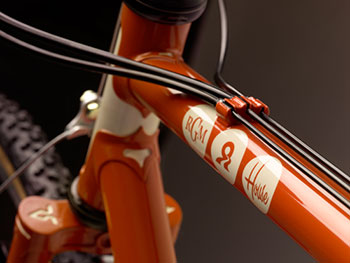
a perceptible downside to this fact is that the weather experienced across the western isles is rarely content to leave such pristine colour well alone, meaning a regular programme of repainting. this usually takes place in the summer months when there's a better chance of being able to carry out the process without teaming rain washing it all across bowmore main street. this past summer, that is exactly what our neighbour's son-in-law completed in our unfathomably sunny and mostly warm weather.
an additional custom around these parts (and elsewhere for all i know), is the offering of some smartass remark on the passing, to anyone who appears to be involved in some form of necessary domestic duty. in this case, said gentleman traipsing up the street clad in a paint spattered boiler suit carrying brush and paint.
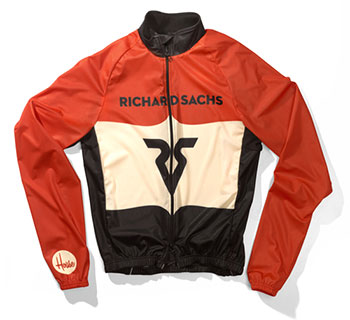
at this point it is necessary to digress just a tad and explain to the uninitiated the insidiousness of the football obsession throughout almost every region of scotland, even allowing for our geographic estrangement from any notable scottish teams. from the time of my youth at school, the two principal soccer adversaries both on and off the field have been glasgow rangers (blue) and glasgow celtic (green). supporters of the former would avoid having grass in their garden if they could possibly manage it.
so at the point of my meeting the rangers supporting painter approaching the all but wholly decorated establishment, i thought it a humorous diversion to mention that i had spoken to his mother-in-law and she'd mentioned that, instead of white, perhaps green would be a pleasant alternative. his riposte? "there'll be no f***in' green on this street." due to the predominance of rangers supporters on the island, i think this a reply that would find much favour in the principality.

i have, as someone for whom colour plays a major part in the daily employ, never fully understood this transference of vitriol, however light-hearted in intent, from a specific subject to an innocent colour. arguably, it has its origins in the red means stop, and green means go that we all learn as youngsters. on a designated day, the significance of which i'm sure few if any understood, even at primary school, the blues were the polar opposite of green.
some colour choices are not open to argument, and nor can their definition be arbitrarily altered.
but thankfully, such strictures do not apply to all walks (or pedals) of life. in certain circumstances, a sense of design is allowed to prevail even when that change flies in the face of perceived tradition. that last word, 'tradition' is the one mostly responsible for resistance to change, as if quoting it in one's manifesto absolves any onus to look outside the box (so to speak). however, not all are weighed down by such notions, willing not only to explore pastures new, but even to pass the baton to a trusted third party.
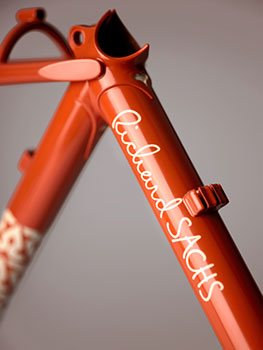
warwick, massachusetts framebuilder, richard sachs, has offered thousands of frames across the years clothed in quality red and white paint by master painter, joe bell. this selfsame colour scheme has decorated the bicycles and clothing that form the basis of the richard sachs cyclocross team. originating from years past when his clothing supplier had "already committed kits to the riders. the fabric was red, and i chose the colour for the team bicycles because it made sense. all these (30) years, the bicycle have remained red."
however, as recently testified to on his website, richard opted to break with both tradition and the thirty year-old red. in other words, a makeover. richard's job is, amongst others, to build the frames, perform duties as general factotum for his cyclocross team and race for all he is worth. in this case at least, design and appearance wasn't on the list. that job was gratefully handed over to rich roat and his colleagues at house industries a digital foundry based in yorklyn, delaware. (house industries have been a co-sponsor of the richard sachs cyclocross team for several years.)
whose idea was the redesign; richard's or house industries'? "About 22 months ago I asked Rich Roat and House Industries to take a look at my identity program, deconstruct it, and create something for me with what was left."
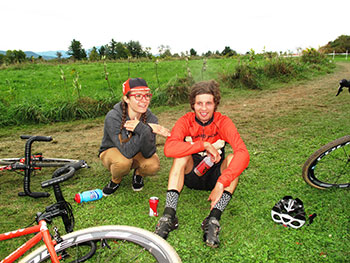
more often than not, re-designs applicable to bicycle racing teams are as a result of a change in sponsor or possibly even bicycle supplier. neither was the case for the richard sachs cyclocross team, who must buck the itinerant trend in cycle sport by having retained the same sponsorship portfolio for many a successful year. sachs elicits such loyalty. but tradition often has a tenacious grasp upon the day to day, so did richard leave it all up to house, or were there certain no go areas?
"No. I basically gave them the keys to the car and said, "Here, you drive this thing.""
i truthfully have no idea if there are consultants inhabiting the bicycle industry, ready and willing to provide design expertise to any existing or prospective cycle racing team. the reality may well be more rudimentary than that. but though house industries have been happy to continue a mutually beneficial relationship with the team, it seems something of a stretch to extend that to effectively altering the way everything is perceived from this point onwards. how does a font provider approach the process of redesigning all aspects of a bicycle race team?
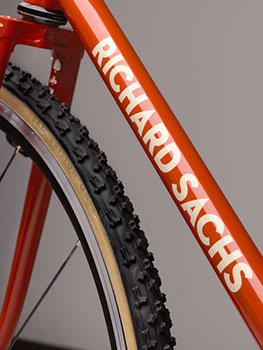
"First of all, we started twenty years ago as a design company and have always tried to let good design drive any project we work on. We introduced the fonts early on as a way to supplement and support our design habit, and the two disciplines have played off of each other ever since."
so is this something that eveloved as it progressed, or were the ideas cut and dried more or less from day one? "Like any House Industries venture, the Richard Sachs project grew and evolved as we dug deeper. It started as a redraw/rework of the downtube logo and gradually creeped into us redesigning the team kit and anything else we could get our hands on as we gained more appreciation for and attachment to the Richard Sachs oeuvre."
there are any number of reasons as to why commerciality would wish to sponsor a bicycle race team. an expanding of awareness, expanding of geographical boundaries, or something even as crassly simple as being a cheaper form of advertising than offered by any alternative project. or, as is apparently the case with that of house industries and richard sachs, a symbiosis external to any real commercial objectives on behalf of either party. as house chief rich roat mentioned in an interview with twmp a couple of years ago "I thought that there was a certain correlation with his manifesto and our sometimes quirky 'business' model."
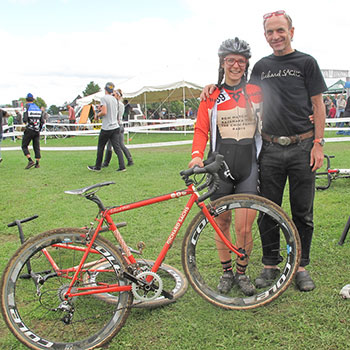
but in the case under discussion, how does roat see it all relating to his partnership with richard sachs and house industries' principal concerns? "Our core business has always been doing good work with good people, then promoting the work in a way that helps sustain our business. Our relationship with Richard is based on the currency of mutual respect and we hope to keep building on what we've done together indefinitely. Or at least until Richard gets tired of us sweating him to let us restyle things."
the new team kit, redrawn sachs top tube signature, neutraface no.2 titling font on the downtube and saffron paint scheme present a modern, yet subtle change from the traditional red and white. from a personal point of view, i'd venture to welcome it as an unqualified success, and i have already placed my order for a long-sleeve jacket, cap and rs socks. though i do not possess a richard sachs bicycle (one day, perhaps), i'd really quite like some of the style to rub off on yours truly.

however, richard's non-attachment to the vestiges of tradition might concevably be at odds with those of his customers. with a multi-year waiting list, it's just possible that some of those with their names in the book might not share his saffron enlightenment, having harboured a long-held desire for red and white. can those with a frame on order stick with the 'old' colours if they wish?
"No.
"And this is not a new thing at all. I have had quite a few art file revisions through years. Decal scales change. Ink colors get bolder or more opaque. The frame reliefs get trimmed with different shades of paint. Font borderline weights have evolved. Even the reds and whites we have used all along since 1981 have had more variations than I can remember.
"When any single line in the sand was crossed, we never went back to what came earlier. It's no different this time. The graphic details that House Industries created for me are now the default art that comes on my bicycles. And the red and white scheme that so many are familiar with is now part of my past."
the first official outing in new garb took place this past weekend at the catamount grand prix in williston, vermont.
richard sachs cyclocross team | richard sachs | house industries
wednesday 18th september 2013
the elite bicycle. gerard brown and graeme fife. bloomsbury hardback illus. 224pp

the human race finds itself well acquainted with the concept of reverence, a form of praise heaped upon the worthy from both near and afar. naturally enough, this acclaim varies depending on the circle of influence and interest in which each individual finds themselves involved, and its application does not constitute a given under all normal circumstances. there is no overweening need to stretch beyond the bounds of notional appreciation, though for reasons which escape me, that seems to be less and less the case.
witness the magazine rack space in whsmith given over to raw cmyk covers celebrating anyone designated a celebrity. sadly a snowballing of the requirement to continually refresh the number of celebrities available for regular consumption means that many's the person who has become famous for being famous. and at that point, the whole process becomes rather redundant.
but there is no doubt that there are many within the world of the peloton and velocipede that are deserving of our reverence, even if that extends no further than acknowledging a level of ability and creativity that seems greater than our own. riders such as coppi, bartali, anquetil, simpson and others have lengthy palmares that display their tenacity above and beyond regular cycling activity. apply the same reverence to those less concerned with competitive achievement and more with the provision of the tools for success, and who would argue with the elevating of colnago, de rosa, pinarello and their peers to the selfsame pantheon?
i have deliberately restrained myself from adding to the above with characters and companies of more modern construct, principally because messrs brown and fife have stepped in ahead of me. their large format book entitled the elite bicycle also blurs the lines of reverence between that applied to individuals working industrially without one whit or care for our attentions and the results of their ministrations. for me, that is the contradiction, not in the manner of their presentation, but in our own apparent desire to foist great esteem upon inanimate objects, principally on the misapprehension that they are anything but inanimate.
if i relate a few chapter headings from this superbly illustrated book, you may gain a better idea of that of which i speak: brooks, columbus, condor, richard sachs, tony pereira, selle italia and ira ryan. intriguingly, there are apparent omissions that quiz just as much as they intrigue. for instance, none of the majors mentioned above seem to have made it into print, immediately casting a possibly deliberate level of subjectiveness upon the book's title. there is no doubt that many of us would be pleased to argue with gerard and graeme as to why our own elite bicycles seem to be missing in action.
though the book's applied subtitle is portraits of great marques, makers and designers, the emphasis seems to rest heavily upon the individual (up to a point), rather than the corporate. but truthfully and rather obviously, a book that included each and every elite bicycle would strain the resources of any of the world's publishing houses, to say nothing of the work ethic of the authors and photographers. there is however, an eclectic mix of the big fishes in the pond (mavic, time, continental) and the minnows (by which i mean no disrespect) several of which i have already brought to your attention.
in his remarkably brief foreword, tailoring supremo sir paul smith merely adds to the confusion "This wonderful book,...really celebrates the passion of people who are still content to make things, in small quantities, by hand." it concerns me slightly that sir paul apparently thinks that mavic, time, brooks, sapim and reynolds (tubing) make things in small quantities. and by hand.
however, ignore the rhetoric (both his and mine), and this is a particularly fine book to have on the bookshelf. not altogether unexpectedly, the photography is well presented, well chosen and of a quality that does the authors great credit. additionally, one has to wonder whether the elite apellation is in place at the behest of the publisher, for the text gives no hint that the included individuals and corporates could be said to be ultimately superior to the absent majority. but it is undeniably reverential in tone; "Handsome, sleek, unmistakeably classic in design, the Singer bikes which line the tiny showroom, near the counter on which stands an old lever-operated cash register, have a touch of antique class which even toe-clips cannot efface. And the tradition."
there is many a page illustrated with the tools of the genre: vices, files, saws, jars of paint and a plethora of images depicting the intensity of thought and work ethic involved in providing us with the wherewithal to play out our own reverences in public.
there is, almost casually, a subliminal degree of learning and education on show via many a photo caption and editorial paragraph. witness this from the chapter concerning ben serotta (now sadly no longer at the head of his own company) 'It came, he said, from a light bulb moment. Ben was drinking beer with a doctor friend, poring over a copy of Gray's Anatomy in the hope of bolstering his own hands-on expertise with some science. His friend told him this was misguided. 'You can't treat the body as a machine' he said, 'you must look at the cyclist as a whole.'
the hotbed of cycling in north america's pacific northwest is not ignored (breadwinner, pereira, ryan, chris king and winter bicycles), but neither is homegrown talent on this side of the pond; rourke, brooks, condor, and royce. unusually the treads on which we roll are also brought into play, almost at opposite ends of the spectrum, from the industrial magnitude of germany's continental, to the three person hand process at fmb in brittany.
it's these almost bizarre contrasts that makes the elite bicycle a candidate for due reverence of its own. far from being just another coffee table book it contains far more than a compendium of pretty pictures and vacuous platitudes, though i do have a few reservations over the inclusion of sir paul's slightly misleading foreword. £35 may seem almost as hefty as its physical substance, but the contents could conceivably alter your perspectives and the flavour of bike in the shed.
but it is every bit as enjoyable as illustrated testament to a portion of contemporary velocipedinal activity.
tuesday 17th september 2013
 ..........................................................................................................................................................................................................
..........................................................................................................................................................................................................